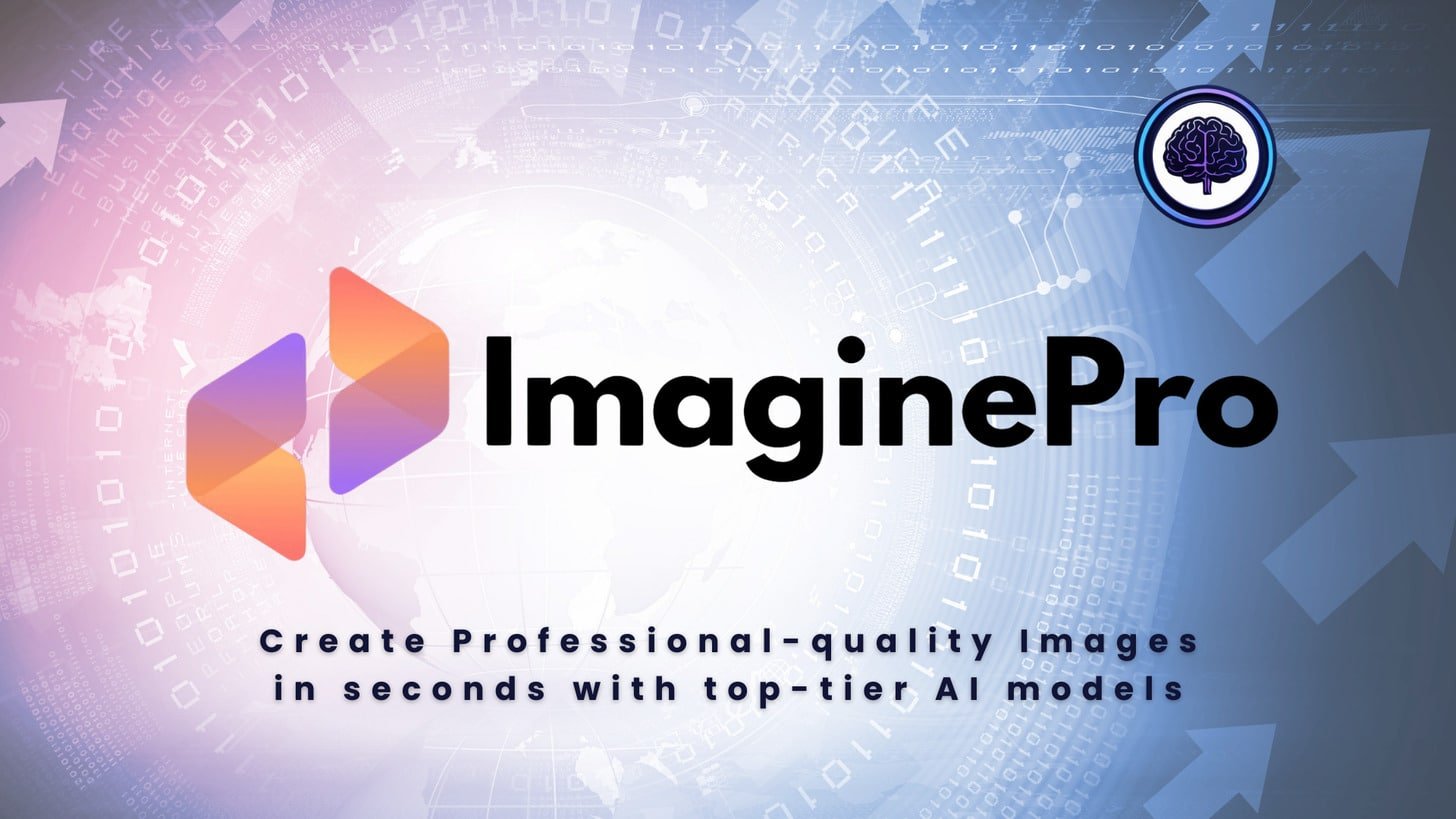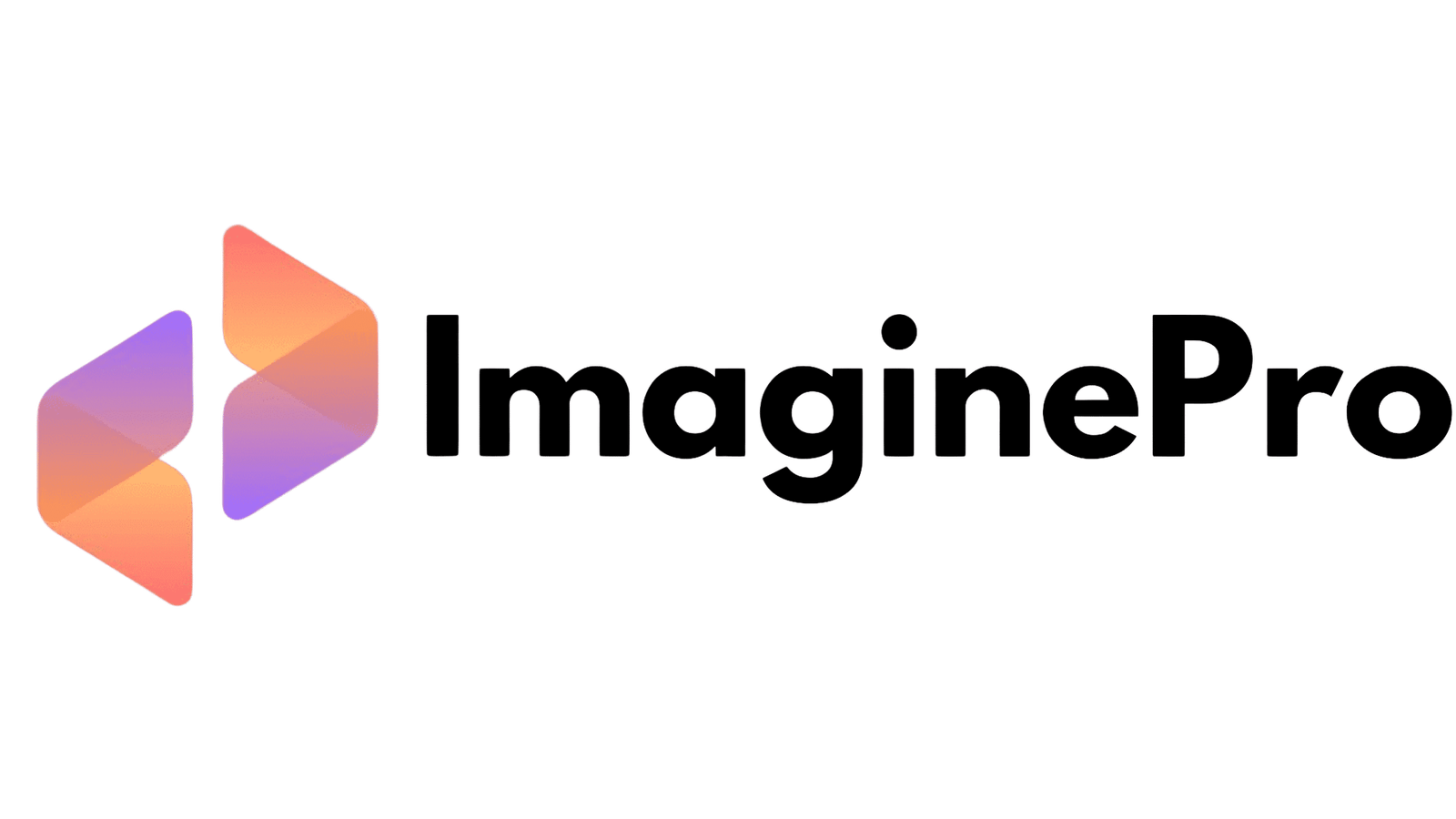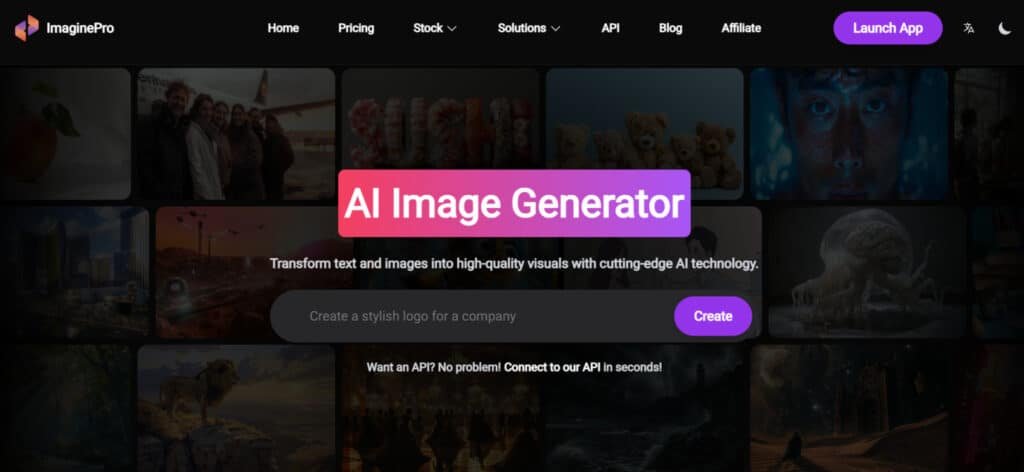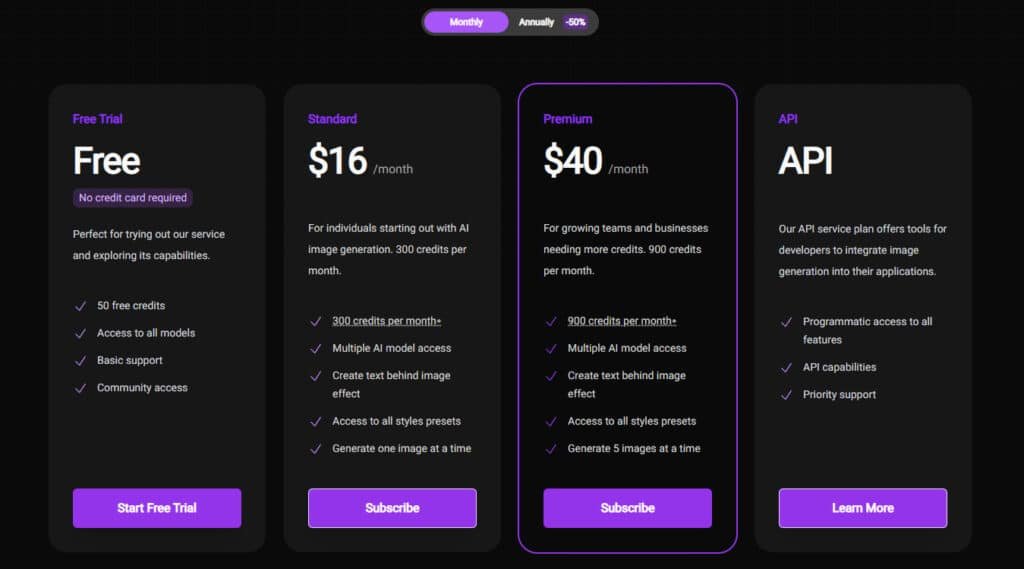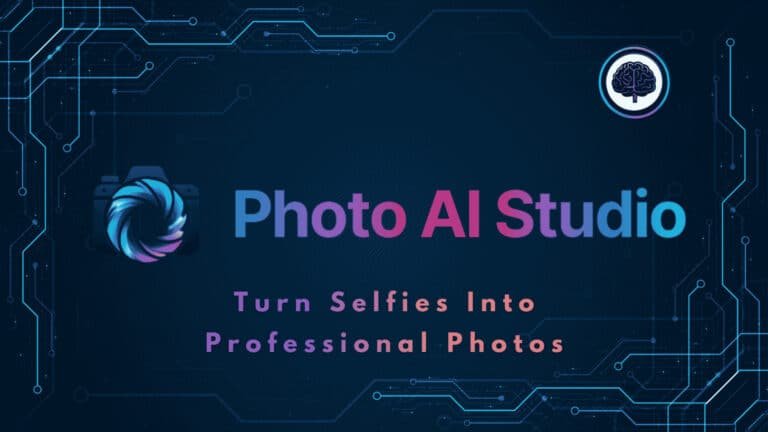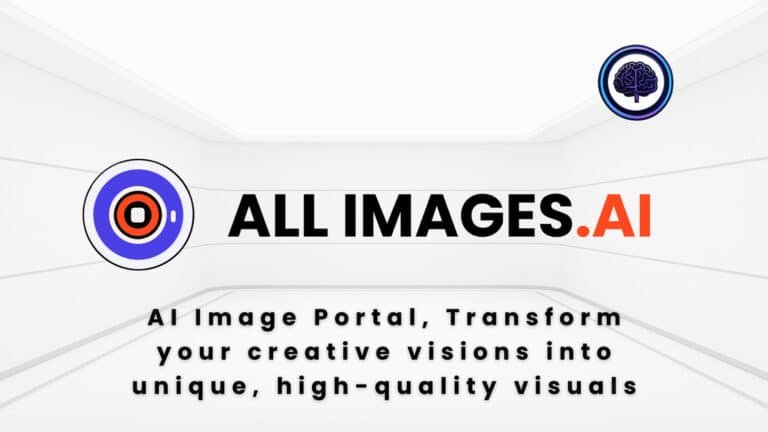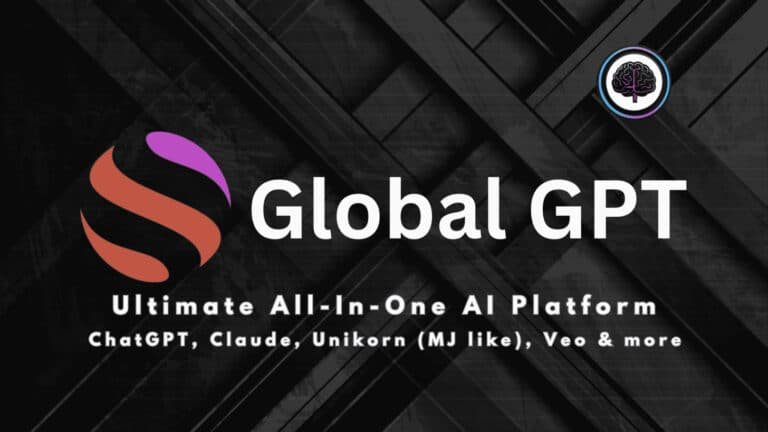You need high-quality visuals fast, but traditional design workflows slow you down and cost too much.
That lag kills deadlines and bloats budgets—especially when clients demand multiple revisions, transparent pricing, and commercial-ready output.
I’ve tested an AI-powered image generation platform that claims to solve this: it pairs text-to-image, background removal, and a “Text behind Image” feature with an intuitive web UI.
In my hands-on time, the tool produced consistent, high-res images quickly. The Free Trial (50 credits) and clear monthly tiers make it easy to test without risk. I’ll break down the pricing, core features, credit usage, and real-world speed so you can judge value.
If you want to know who benefits most—freelancers, marketing teams, or API users—this piece gives a practical, first-person take and a firm recommendation. Let’s dive in.
Key Takeaways: ImaginePro Review
- The platform speeds up image generation and streamlines visual workflows.
- Free trial offers 50 credits—useful for testing results before you commit.
- Monthly plans balance cost and volume (Standard and Premium tiers explained later).
- Core features include text-to-image, background removal, and “Text behind Image.”
- I’ll show when to upgrade and how the API fits scaling needs.
ImaginePro Review: An Overview
Raamish’s Take
ImaginePro is a solid AI image generator that turns ideas into visuals in no time. I like how it saves you from costly photoshoots with its instant masterpieces feature, creating pro-quality images fast.
The creative control lets you tweak styles and colors easily, while high-quality images deliver lifelike, high-res results perfect for any project.
It’s editing features like Background removal cleans up shots effortlessly, and text-behind-image adds a cool magazine-style touch. The intuitive web UI keeps it simple for beginners and pros alike.
Compared to Midjourney, ImaginePro offers a smoother experience with API access for developers. Ever need quick, polished designs? This is a great pick for boosting creativity without the hassle.
Introduction to ImaginePro: Where It Fits in Today’s AI Image Landscape
Not every image AI aims to be experimental art; some aim to reliably produce assets you can ship today. This web tool emphasizes speed, predictable output, and an easy learning curve — a solid middle ground between consumer generators and developer-centric ML studios.
Who’s behind it and the vision for AI visuals
I’ve seen the team mix product designers and engineers who pushed for a clean UI and clear credit model. Their goal was simple: give designers and developers a fast way to create commercial-ready imagery without wrestling complex settings.
Purpose, positioning, and who’s using it in
Purpose: accelerate asset creation for campaigns, product pages, and social content.
- Users include designers building brand kits, marketers producing ad creative, and developers automating image generation via API.
- Teams value the predictable pricing, integration options, and features like background removal and text-behind-image.
Compared to Seedream 4.0, NanoBanana, and Gemini 2.5 Flash Image, this solution favors practical controls and fast throughput — no invite drama, just reliable capabilities and a generous trial to test workflows.
What is ImaginePro?
From idea to asset: enter text prompts, pick a style, and the tool produces polished visuals you can use right away. The interface keeps options simple while exposing key controls for more precise results.
How the platform works: from text prompts to high-resolution images
The flow is straightforward. You type a prompt, choose style and aspect ratio, then select quality or performance settings. Under the hood, multiple AI models run the image generation process; the system composes color, lighting, and composition to produce lifelike results.
“A few prompt tweaks usually dial in the look fast,” — my experience after several test runs.
Post-process tools—like background removal and text behind effects—let you refine output without leaving the UI. Developers can swap models via API to alter tone and performance for different projects.
Benefits for creators, marketers, designers, and developers
- Creators: faster ideation to creation, fewer app switches.
- Marketers: ad-ready images sized and styled for campaigns.
- Designers: control over composition and lighting without long edits.
- Developers: automated generation at scale with predictable credits.
The big win is reliable, commercial-grade output — including high-resolution images you can ship across web, social, and print with little fuss. I find imaginepro pragmatic and fast for team workflows.
Who It’s For
If you need dependable visuals fast, this tool cuts the hours between idea and publish-ready art. Below are quick highlights to help you decide. Read this if you want a clear sense of who benefits and how to put the platform to work.
Key takeaways at a glance
- Fast generation: rapid turnaround for social content and product listings.
- Commercial-ready outputs: clean exports and useful effects (background removal, type treatments).
- API for scale: automate batch renders and push assets into a CMS or ad system.
Ideal users, use cases, and project types
The platform suits designers, marketers, and developers—particularly social media managers and e-commerce teams. Agencies and dev squads building content automation also gain value.
Project sweet spots include Instagram/TikTok visuals, PDP images, landing page heroes, and campaign variations where consistency matters. Match your needs to the credit tiers: light projects fit Standard; recurring campaigns belong in Premium.
I recommend a two-week pilot to verify output against your brand standards before committing.
Best Features of ImaginePro
What follows are the core features I rely on when I need polished visuals fast. Below I explain each capability, why it matters, and where it fits in a pro workflow.
1. Image Generation Capabilities
Kreado AI delivers robust text to image AI and image-to-image generation, enabling users to create high-quality visuals swiftly. This feature supports diverse applications, from social media AI visuals to professional marketing materials, helping users with search intent for creative solutions to produce engaging content efficiently.
1.1 Text-to-Image and Image-to-Image Generation
Using advanced models like Midjourney and Flux, Kreado AI transforms text prompts or reference images into high resolution AI art up to 2048×2048 pixels. Users can customize outputs with aspect ratios, stylization, and quality settings, ideal for those seeking photorealistic AI generator outputs or anime AI art for creative projects.
1.2 Batch Processing and Speed
The platform supports batch generation, allowing multiple commercial AI images to be created simultaneously with fast processing. This benefits users needing AI marketing tools for quick turnaround on ad campaigns or e-commerce product images AI, ensuring efficiency and scalability.
2. Image Editing and Enhancement Tools
Kreado AI’s editing suite provides precise control over visuals, catering to users searching for AI photo editing or AI graphic design tools to refine images for professional or creative purposes.
2.1 Background Removal
The AI background removal feature extracts subjects from images effortlessly, perfect for e-commerce product images AI, headshots, or social media AI visuals, enabling users to create clean, versatile visuals for various platforms.
2.2 Text-Behind-Image Functionality
With text behind image AI, users can place customizable text behind subjects, creating magazine-style visuals. This is valuable for designers seeking poster banner AI solutions to enhance branding or promotional content.
2.3 Advanced Editing Features
Inpainting, outpainting, upscaling, and style transfers allow detailed edits, such as pose changes or consistent character AI across scenes. These tools help users searching for AI wallpaper generator or sketch to art AI to polish their creative outputs.
2.4 Specialized Outputs
Kreado AI generates headshot generator AI outputs, logos, and brand mascot AI, supporting users needing professional ID photos or AI video cover images for marketing and social media.
3. User Interface and Accessibility
The intuitive interface of Kreado AI simplifies AI image generator workflows, making it accessible for users seeking AI graphic design or AI social media images solutions without technical expertise.
3.1 Intuitive Web Interface
A user-friendly web UI with templates and style presets supports beginners and professionals, ideal for those searching for an AI logo generator or AI posters & banners to create visuals quickly.
3.2 Community and Resources
Community forums and documentation provide support for AI animal generator or AI Christmas visuals, helping users explore creative possibilities and troubleshoot effectively.
4. API and Developer Tools
Kreado AI’s Midjourney API and Flux AI model integration offer developers robust tools for AI for developers, enabling seamless integration into applications.
4.1 Ultra API Access
The Ultra API supports programmatic batch image generation AI, with SDKs and webhooks, benefiting developers searching for a scalable developer AI API for app development.
4.2 Developer Features
Concurrent job processing and a sandbox environment ensure reliable AI architecture visuals or AI interior design outputs, catering to developers needing enterprise-grade solutions.
5. Supported Applications and Use Cases
Kreado AI’s versatility supports multiple industries, from AI marketing tools to AI photography, addressing diverse user needs.
5.1 Marketing and Advertising
Create poster banner AI and ad variations for A/B testing, helping marketers searching for AI marketing tools to optimize campaigns and boost ROI.
5.2 Graphic Design and Creative Projects
Generate anime AI art, AI comic generator outputs, or AI wallpaper generator visuals, supporting creatives seeking unique designs.
5.3 Photography and E-Commerce
Produce AI photography portraits or e-commerce product images AI, ideal for photographers and retailers needing professional visuals.
5.4 Architecture and Interior Design
Design AI architecture visuals or AI interior design layouts, assisting architects and designers with innovative concepts.
5.5 Social Media Content
Craft social media AI visuals or AI text behind images, enabling influencers and businesses to create engaging posts.
6. Support and Additional Resources
Kreado AI provides comprehensive support, ensuring users can maximize ImaginePro’s capabilities for their projects.
6.1 Credit-Based System
A flexible credit system governs in painting AI tool and upscaling AI images usage, with clear documentation for users planning resource allocation.
6.2 Community and Documentation
Access to Telegram, forums, and FAQs supports users exploring AI girl generator or nano banana AI editor, ensuring effective use of all features.
7.Intuitive Web interface, API, Batch options, and High-Res Output
The intuitive web interface uses presets for lighting and color so you stay focused on output. Developers get multi-model API access for programmatic generation and variants.
“These features cut tool-switching and let teams go from idea to deliverable without friction.”
| Feature | Why it matters | Best use |
|---|---|---|
| Text-to-Image | Fast composition and consistent style | Concepting, campaign visuals |
| Background Removal | One-click cleanup, fewer edits | Product catalogs, banners |
| Text Behind | Editorial depth and polish | Posters, hero images |
| API & Batch | Scale and variant testing | Automated image pipelines |
Prompting, Models, and Quality Controls
If you want predictable output, start by treating prompts like short design briefs. I find concise directions beat long essays—say who, what, and where, then add a style tag. This approach speeds iteration and improves generation consistency.
Crafting better text prompts: styles, lighting, and framing
Lead with subject + action + context + style. Call out lighting and lens cues—“soft daylight,” “35mm shallow depth,” or “studio key light.” Specify angle and aspect ratio for composition (square for social, wide for hero images).
Choosing models and parameters to match your aesthetic
Pick models that match the vibe—illustrative or photorealistic. Use API options to swap models when texture or color is off. Presets are useful starters; layer specifics like materials and time of day to reduce guesswork.
Consistency tips when results vary with identical prompts
When variance shows up, add seed values, lock style tokens, or tighten descriptors. For product work, fix camera distance and background notes. Keep a prompt library tagged by channel and brand—fast reuse equals fast delivery.
Pro tip: Adjust the most influential token (style or lighting) first—this saves credits and cycles.
- Use short text prompts rather than paragraphs.
- Call out lighting, lens, and framing to guide composition.
- Switch models when a look fights your brief and reuse style tokens for sets.
Pricing Plans for ImaginePro
Budgeting for image tools is about matching credits to real monthly projects—not guessing. Below is a clear cost breakdown so you can pick the right plan for your workflow.
Free Trial
The Free Trial plan offers initial access at $0, with no credit card required. It includes 50 free credits, access to all models, basic support, and community access, ideal for exploring capabilities without commitment. Available monthly or annually on the same terms.
Standard Plan
The Standard plan suits beginners at $16/month (monthly) or $8/month (billed annually with 50% off). Features encompass 300 credits/month, multiple AI model access, text-behind-image effects, all style presets, and single-image generation, supporting individual AI image workflows.
Premium Plan
For teams, the Premium plan provides $40/month (monthly) or $20/month (billed annually with 50% off). It delivers 900 credits/month, multiple model access, text-behind-image, all presets, and up to 5 simultaneous generations, enabling scalable business use.
API Plan
The API plan targets developers with programmatic feature access, API capabilities, and priority support. Pricing is separate; details on the dedicated page support app integrations.
| Plan | Monthly Price | Annual Price (50% off) | Credits/Month | Key Features |
| Free Trial | $0 | $0 | 50 | All models, basic support |
| Standard | $16 | $8 | 300 | Text effects, single gen, presets |
| Premium | $40 | $20 | 900 | 5x gen, team-focused |
| API | Separate | Separate | Varies | Programmatic access |
Quick tip: Estimate how many images and edits you need per month, then match that to credits—this avoids mid-cycle surprises and keeps your pricing predictable among the available options.
Credit System Explained
Credits are the engine behind every operation — know what burns them and when.
How credits are consumed:
Generation vs. edits
Full image generation costs more than edits. A single render uses multiple model cycles. Basic edits—like background removal—use fewer cycles and cost less per action.
I track typical use per deliverable. For example, one hero image might need two generations plus a background cleanup. That helps forecast monthly needs and avoid surprises.
Scaling projects and when to upgrade
If you hit limits before the end of the month, consider Premium for higher headroom and concurrency (up to five parallel renders). For heavy automation, move batch jobs to the API, which bills usage-based and can run off-peak.
My rule: if credits constrain experimentation, upgrade — throttled creativity costs more than a bigger plan.
| Action | Relative cost | When to plan |
|---|---|---|
| Full generation | High | Creative exploration, hero images |
| Background removal | Low | Product catalogs, batch cleanups |
| Variant renders / batch | Medium–High | Campaign weeks, multi-size sets |
- Tip: use the removal tool for bulk product edits—it’s efficient and saves time.
- Plan a buffer: campaign bursts often need extra credits in a month.
- Track: log credits per image to refine forecasts and decide when to upgrade.
Setup, Onboarding, and User Experience
Getting started should be the shortest part of any tool — and here it is.
Signing up only took a minute, and I was staring at my first render within moments. The clean interface walks you through a short tour, then drops you into a prompt field and a row of presets.
From signup to your first image in minutes
The account flow asks for essentials and verifies email fast. No long tutorials — just a few pointers that point you at presets for lighting, framing, and color.
I recommend you save one favorite style and an aspect ratio right away. That gets you repeatable results for social posts or hero banners without retyping the same directions.
Using the web interface: presets, options, and workflow tips
The intuitive web interface groups options logically: presets at the top, prompt in the center, and quick-edit tools on the side. You can run a render, then apply background cleanup or small edits without leaving the page.
“Short loops of prompt → render → tweak keep quality rising with minimal time spent.”
- Save favorite styles and aspect ratios for recurring formats.
- Name outputs with a convention that includes the seed for easy re-renders.
- Share presets with teammates so everyone hits the same visual target.
| Step | What it does | Quick tip |
|---|---|---|
| Signup | Creates account and grants trial credits | Verify email to unlock full presets |
| Preset selection | Locks lighting, color, and framing | Save one per channel (IG, web, banners) |
| Render & edit | Generate image and apply cleanup tools | Use background removal for product shots |
| Versioning | Name files and record seeds | Easy re-renders and team consistency |
If you want to use imaginepro efficiently, treat the UI like a moodboard-to-render shortcut: sketch in text, pick a preset, then refine. The intuitive web flow rewards quick iteration and keeps editing tools within reach.
Pros & Cons of ImaginePro
You get quick renders and polished results, yet a few limits are worth noting.
Pros
- Speed: Renders arrive fast, keeping momentum high when deadlines loom.
- High-quality visuals: Outputs look polished and often need only minor editing to ship.
- Interface: A clean UI shortens onboarding and helps teams adopt the tool quickly.
- API integration: Developers can automate pipelines and scale generation for internal apps.
- Useful features: Tools like background removal and text effects cut time spent in separate apps.
Cons
- Credit limits: Lower tiers can pinch during campaign weeks—plan ahead or upgrade to avoid throttling.
- Prompt variance: Identical prompts sometimes yield different results; consistency practices (seed reuse, style tokens) help.
“If speed and professional output matter, this tool delivers; just match your volume to the right tier.”
If fast turnaround and consistent, campaign-ready images matter to you, this platform is a strong fit for many users. It bundles practical features and decent automation options.
However, heavy-volume teams should map expected output to credits to avoid mid-cycle limits.
For teams where unlimited usage or specialized aesthetics are must-haves, there are solid alternatives to compare next.
| Aspect | Strength | Weakness | When it fits |
|---|---|---|---|
| Speed | Fast renders | Credit-driven throttles on low tiers | Campaigns with tight deadlines |
| Output | Polished, commercial-ready images | Occasional prompt variance | Product pages, ads, social |
| Tools | Background removal & editing helpers | Advanced editing still needs external apps sometimes | Catalogs and hero assets |
| Scale | API for automation | API costs scale with usage | Automated pipelines and internal tools |
Alternatives to ImaginePro
Different tools fit different workflows. Choosing the right image platform comes down to the models available, integration depth, and the output your team needs every week.
ImaginePro nails that with quick text-to-photo gens, background zaps, and text-behind-image tricks. It’s a pro pick for marketers whipping up social visuals—$8/month gets you 300 credits. Solid start, but what if you crave wild styles or batch power? I’ve tested these six rivals; they crank up the creativity without the hassle.
GetImg.Ai rocks character consistency—same face across scenes, plus inpainting for tweaks. Love it for storyboarding; free 100 credits/month, then $12/month unlimited.
Midjourney? Pure magic for artistic flair. Discord chats along with web generator spark ideas, high-res outputs shine. No free ride, but $10/month basic unlocks endless remixes. (Why Discord? Feels like jamming with creators.)
Imagine.Art dives deep with 70+ styles, remixing, and video clips. Perfect for artists playing around; free tier teases, $7/month pro unleashes HD.
Flux.Ai delivers hyper-real shots—prompts nail details like never before. Speed demon for pros; free credits hook you, $10/month for pro models.
Artspace handles 4K ups, face swaps, no censorship. Batch bliss for teams; 7-day free trial, lifetime $77 deal? Game-changer.
Artsmart.Ai lets you pose-swap and upscale cheap. Fun for beginners; starts $19/month, but credits fly low.
Stuck on realism or fun?
These can compete with ImaginePro’s polish with extras that save hours. What’s your next project—a logo or epic scene?
| Tool | Key Strengths | Starting Price | Best For |
|---|---|---|---|
| ImaginePro | Text-to-image, bg remove, text effects | $8/mo | Quick marketing & social visuals |
| GetImg.Ai | Character consistency, inpaint, API | $12/mo | Storyboards & series branding |
| Midjourney | Artistic styles, community remixes, high-res | $10/mo | Creative artists & idea jams |
| Imagine.Art | 70+ styles, video, remix tools | $7/mo | Experimental art & animations |
| Flux.Ai | Hyper-real prompts, fast pro models | $10/mo | Photoreal pros & detail freaks |
| Artspace | 4K upscale, face swap, batch gens | $77 Life time | Teams & unlimited commercial art |
| Artsmart.Ai | Pose copy, upscaler, beginner prompts | $19/mo | Fun edits & low-cost experiments |
“Try two or three contenders with the same brief — the one that nails your look fastest will save the most time and credits.”
If you want a straightforward web workflow with clear costs and fast results, I still find the baseline option compelling.
But test contenders side-by-side to confirm which platform fits your design needs, integration requirements, and budget plan.
Real-World Use Cases and Results
Practical outcomes matter — here are concrete use cases where fast image generation saved time and budget.
Social media campaigns
I’ve used the tool to spin up on-brand Instagram carousels in minutes. Consistent color palettes and locked framing made feeds feel cohesive across posts.
For TikTok and X, fast turnarounds let teams drop topical visuals mid-campaign without booking a shoot. That kept engagement high and production costs low.
E-commerce and background work
Background removal at scale normalized product photos in our catalog. Clean PDPs shipped faster and conversion-focused images stayed consistent.
Batch removal and bulk exports reduced manual edits and trimmed project timelines from days to hours.
Marketing materials and ads
Landing page heroes with negative space were quick to iterate — adjust color, lighting, or mood and export variants for A/B testing.
Ads benefitted from multiple variants per concept, which improved audience targeting and test velocity.
Developer integrations
Automating image creation via API let us generate social cards on publish and dynamic headers in our CMS. Integration removed repetitive tasks and scaled production.
“Move from brief to first draft in under an hour — approvals focused on direction, not technical fixes.”
| Use case | Outcome | Typical prompt | Why it matters |
|---|---|---|---|
| Social campaigns | Faster rollout, cohesive feeds | “photorealistic group near branded product, soft daylight” | Brand consistency and speed |
| E-commerce catalogs | Cleaner PDPs, less manual edit | “product on white, remove background, 1:1” | Higher conversion, faster updates |
| Marketing & ads | Multiple A/B variants | “hero image, negative space for copy, moody lighting” | Better testing and personalization |
| API automation | Dynamic assets at scale | “auto-generate social card from post metadata” | Operational efficiency and integration |
Operational wins: Build a prompt/style library, lock composition notes, and let new projects inherit proven settings. The result: cleaner catalogs, more agile campaigns, and measurable time savings in both production and iteration cycles.
Case Study / Personal Experience
For a recent spring push I set a tight brief and timed every step to see how fast I could ship usable assets.
Project setup, prompts used, and time-to-first-result
I planned a hero image plus three social variants for a DTC brand—warm light, fresh palette, and clear space for a headline and CTA. I saved aspect ratios and lighting presets, then reused a seed and style tokens to keep things cohesive.
I used short, specific text prompts with lens cues (e.g., “soft daylight, 50mm, shallow depth”). That cut retries. Generation to the first usable image took about five minutes.
Before-and-after visuals and measurable outcomes
Initial renders were solid. One-click background cleanup and a subtle contrast lift made the assets feel campaign-ready.
Results: faster approvals, consistent look across channels, and less post-production time. The whole project stayed well within a single month of credits with headroom for extras.
My experience: what impressed me and what I tweaked
I was impressed by speed and clarity—less time fighting the tool, more time shaping creative direction. Iteration averaged two tweaks per asset (color temp and prop placement).
“Short prompts and locked seeds turned variance into cohesion—so I spent credits on variants, not fixes.”
- Brief: spring hero + three social cuts (warm, fresh, headline space).
- Workflow: save presets, lock seeds, reuse style tokens.
- Prompts: concise text with lens and lighting cues.
- Outcome: cleaner assets, faster approvals, less editing time.
Bottom line: When you need fast, professional drafts for campaign work, use imaginepro to speed image creation and get ship-ready images with minimal polish.
Which ImaginePro Plan Fits Your Needs?
Choose a tier by matching how your team works each month — steady work, campaign bursts, or programmatic scale. Start by counting how many final images and variants you produce in a typical month. That simple audit tells you whether credits or concurrency matter most.
Matching credits and capabilities to your monthly projects
Standard (300 credits / month) fits light workloads—brand refreshes, occasional ads, or single-image tasks. If you create a few hero images and social posts, this keeps pricing predictable without overbuying.
Premium (900 credits / month) is for medium to high volume. Weekly campaigns, catalogs, or teams that need up to five parallel renders benefit from higher throughput and faster variant testing.
When to leverage the Premium plan or switch to API
If you hit 70–80% of your credits mid-cycle, upgrade. Seasonal spikes are common—move month-by-month or use the API for flexible, usage-based scaling.
- Agencies with parallel briefs should lean Premium for concurrency and fewer bottlenecks.
- Choose the API when content is programmatic — dynamic social cards or automated product updates.
- Include A/B testing in forecasts; variants multiply credit use but often improve ROI.
- Centralize prompts and presets to cut retries and save credits per deliverable.
| Workload | Best fit | Why |
|---|---|---|
| Light (occasional ads) | Standard — 300 credits | Predictable, cost-efficient |
| High (weekly campaigns) | Premium — 900 credits | Concurrency and volume |
| Automated / scale | API (usage-based) | Flexible billing, programmatic workflows |
Practical tip: If you’re unsure, start Standard for one month and track credit burn. Switch to Premium or API when creative speed is constrained—time saved often outweighs small pricing differences.
Conclusion
Raamish’s Take
ImaginePro is a solid AI image generator that turns ideas into visuals in no time. I like how it saves you from costly photoshoots with its instant masterpieces feature, creating pro-quality images fast.
The creative control lets you tweak styles and colors easily, while high-quality images deliver lifelike, high-res results perfect for any project.
It’s editing features like Background removal cleans up shots effortlessly, and text-behind-image adds a cool magazine-style touch. The intuitive web UI keeps it simple for beginners and pros alike.
Compared to Midjourney, ImaginePro offers a smoother experience with API access for developers. Ever need quick, polished designs? This is a great pick for boosting creativity without the hassle.
When deadlines pile up, the right image generator turns hours of work into minutes.
In short Imagine.Pro delivers fast, highly realistic in detail, commercial-ready images along with image editing features such as one-click background removal, a handy “Text behind Image” effect, and an API that scales. The free trial gives you 50 credits to validate output against your brand quickly.
If your team needs dependable campaign assets, product visuals, or automated generation, try the free trial and measure time saved. Annual tiers map to typical workloads: 300 credits for steady work and 900 credits for heavy, variant-heavy campaigns.
My take: Imaginepro is practical—fast, highly detailed image renders, a clean UI, and features that cut real effort. Start a test project now, then pick the pricing that keeps momentum high and lets you ship more, faster.
Frequently Asked Questions
What is ImaginePro and who should consider using it?
ImaginePro is a web-based AI image creation and editing platform focused on text-to-image generation, background removal, and layout tools like “text behind image.” I find it best for creators, marketers, designers, and developers who need fast, high-resolution visuals and an intuitive interface.
How does the credit system work?
Credits are the platform’s unit for actions—image generation consumes credits based on resolution and model, while background removal and some editing tools use fewer credits. Track usage in the dashboard and upgrade plans when monthly projects exceed your allowance.
What do I get with the free trial?
The free trial gives 50 credits and access to all models so you can test generation quality, background removal, and presets—no credit card required. It’s enough to evaluate speed, consistency, and whether the visuals fit your brand needs.
How good is image quality for commercial use?
The platform produces high-resolution, print-ready images suitable for commercial projects when you select higher-resolution settings. I recommend testing with the free credits and checking licensing terms for commercial use before large-scale deployment.
Can I integrate ImaginePro into my development workflow?
Yes—there’s API support and multi-model options for developers. The API has separate pricing and usage-based billing, which is ideal for automating generation, batch processing, and integrating background removal into product pipelines.
What are the main pricing tiers and differences?
Plans typically include a Standard plan (about $8/month with 300 credits) and a Premium plan (around $20/month with 900 credits and higher concurrency—up to five images at once). Annual billing often yields discounts. API pricing is handled separately.
How fast are generation and removal tools?
Performance is generally fast—I got results in seconds for single images and minutes for high-res batches. Speed can vary with model choice, resolution, and concurrent requests, but the interface is optimized for quick previews and exports.
Does the platform handle consistency across multiple images?
You can achieve consistency by locking styles, seeds, and model parameters. I do recommend creating a prompt template and using presets or the same model/settings when you need a cohesive set—the platform also supports batch options to help maintain uniformity.
Is the background removal reliable at scale?
The background removal tool is accurate for product photos and simple portraits—it’s designed for speed and clean edges. For complex hair or transparent materials, you may need minor touch-ups, but batch removal makes large runs efficient.
What prompts work best for lifelike results?
Effective prompts mention subject, style, lighting, framing, and desired aspect ratio. For example: “studio-lit product shot, white background, sharp detail, 3:4 aspect ratio.” I advise testing short iterations and refining with attributes like “cinematic lighting” or “macro detail.”
Can I get multiple aspect ratios and sizes for the same prompt?
Yes—the tool supports various aspect ratios and both batch and single-image outputs. Choose the intended use (social, print, hero image) and generate the sizes you need; higher-resolution outputs use more credits.
Are there developer controls for choosing models or seeds?
The platform offers model selection, parameter tuning, and seed control for reproducibility. Developers can program these settings via the API to match an aesthetic or maintain consistent renders across automated jobs.
How does billing work if I exceed my credits?
If you run out of credits, the platform prompts you to upgrade or purchase add-ons. For API users, usage-based billing applies. I recommend monitoring the dashboard and setting alerts to avoid interruptions during campaigns.
What file formats and export options are available?
Exports typically include PNG and JPG for images, with high-resolution options and transparent background support after removal. Some plans or API calls provide direct download links or cloud storage integrations for streamlined workflows.
How steep is the learning curve for new users?
The web interface is intuitive—presets, templates, and a guided prompt workflow help you get your first image in minutes. Developers will find extra controls in the API, but creatives and marketers can be productive quickly without deep technical knowledge.
What are common limitations to watch for?
Expect prompt variance (identical prompts can yield different outputs), credit limits on lower tiers, and occasional edge cases in complex background removal. These are manageable with prompt tuning, presets, and occasional manual edits.
How does this compare to tools like Midjourney or Google models?
This platform focuses on an integrated web UI plus editing tools (background removal, text-behind-image) and developer APIs—so it’s more of an all-in-one image creation and editing workflow. For stylistic experimentation, Magenta or Midjourney alternatives may excel, while this tool shines for production-ready visuals and UX.
Are there presets for social platforms like Instagram or TikTok?
Yes—there are presets and aspect ratio templates tailored for Instagram, TikTok, X, and other channels. Use them to speed up campaign creation and ensure visuals meet platform specs without manual resizing.
Is there customer support and documentation?
There’s documentation for both the web UI and API, plus support channels (help center or contact forms). I found the docs practical for onboarding and the API reference useful when automating generation tasks.
Can I use generated images commercially and what about licensing?
Generated images are generally usable commercially, but licensing specifics vary—always check the platform’s terms of service and any model-specific restrictions before large-scale or resale use.

